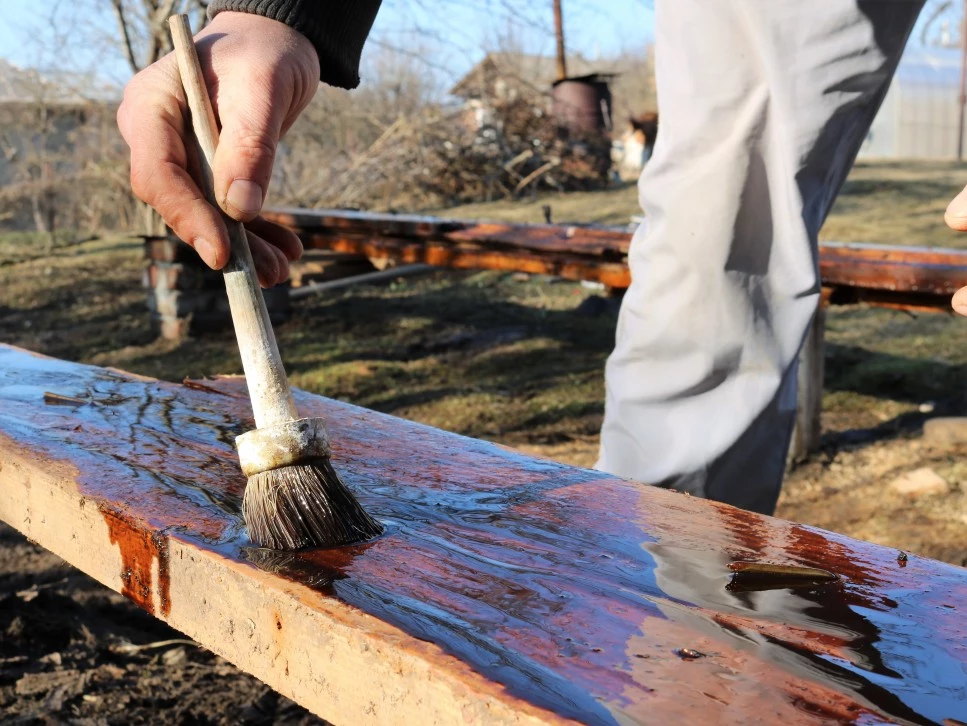Wood furniture has natural characteristics that make it unique. Wood with peeling paint and sticky residue may be distressed and sanded, but the process won’t necessarily make wood look new again. The wood itself will still be the same, only now you’ll have to deal with wood that is even more porous and susceptible to dirt and grime.
I love finishing wood with oils and varnishes. So, when my wife asked me if he could varnish over oiled wood, my brain started spinning. I could picture it, but I wasn’t sure if I could do it. It turns out you can, but there are a lot of steps involved.
How to tell if the wood is varnished or oiled
To determine the finish applied to a piece of wood, there is an easy test you can run that requires a small amount of linseed oil. Rub some of this product onto a small area of the wood. Make sure you choose an inconspicuous area. Apply the linseed oil with a small piece of cotton or tissue. If you see the wood absorbs the oil, it means the wood has an oil finish. However, if the wood begins to bead, it is finished with shellac, Polyurethane, lacquer, or varnish.

Can I varnish over the oiled wood floor?
It is often safe to apply varnish on a wooden surface that has already been polished with oil. Varnish is designed to be compatible with oil because it also contains oil. It is important to note that this doesn’t apply to any water-based varnishes. Be sure to verify the varnish package to determine whether it is compatible with an oil finish.
Can I varnish over danish oil?
It is advisable to add varnish on a surface that has been finished with Danish oil. Adding varnish should help the finish become glossy and stand out. It should increase the durability of the wood and only require maintenance after several years.
Adding varnish to Danish oil will make the wood tear, abrasion, impact, mold, mildew & fungus resistant. Since when dealing with Danish oil, the finish isn’t filmlike, it is advisable to use lacquer because this helps guard against liquid elements.
The critical thing to be aware of is that adding varnish to Danish oil will increase the drying time significantly. Usually, a Danish oil finished surface will be dry and ready to use in 8-10 hours. If you add varnish, this timeline will increase to 72 hours.
Adding varnish will also seal the wood if you want to add extra hardness.
Can I varnish over linseed oil?
Varnish is an excellent option to add to linseed oil. This finish is trendy because it provides the wood with additional strength and rigidity. This feature means the wooden surface will be protected against general wear and tear. There is nothing wrong with applying varnish over linseed oil. This product is not compatible and can result in an unpleasant finish. The product you need to avoid is solvent-based lacquer.

Can you varnish over tung oil?
It is advisable to add a coat or two of oil-based varnish over tung oil. This product works well with tung oil and should help to provide more excellent durability to the finish. It can thin the oil and prevent any drips or brush marks. You should require about three coats. Each applied after 24 hours. You can always add another coat as you notice the old one wears down.
Tung oil is quite similar to varnish because it is highly thinned. This characteristic of the finish means it naturally lacks a high level of durability. Tung oil is highly water-resistant and will serve well as a final finish. A harsher topcoat is highly recommended to make the wooden surface more challenging. Regardless, the product cannot keep up with modern varnish in terms of durability.
Can you varnish over teak oil?
Teak oil is a product designed mainly with a Linseed oil base. Linseed oil is one of the main ingredients found in most primitive varnishes. This compatibility should allow you to combine teak oil and varnish safely. You may find that adding varnish to teak oil is quite a labor-intensive process, but you can often safely apply varnish over teak oil. It is only possible to use an oil-based varnish for this purpose. If you plan to use a water-based varnish, you cannot apply this over teak oil. Check this information by reading the package directions first before applying.
Can you Polyurethane over oiled wood?
You will not experience any problems from adding Polyurethane to oiled wood. It should successfully increase the durability of the wood by forming an oxygen barrier. This barrier will prevent bacteria and mold from forming in the wood. The main challenge you can expect is an increase in drying time. If the Polyurethane is not water-based, the oil should cure perfectly well under a coat of Polyurethane.
Can you varnish over Osmo oil?
Osmo Polyx Oil is often used to help prevent the wood from decaying and losing its natural character and beauty. The oil combines oils and waxes, making it hard-wearing and durable. It is best used when applied directly onto natural wood. Osmo products are not designed to be added to other oil finishes. You can, however, safely apply varnish over Osmo oil. It is essential to avoid any water-based varnishes because these are not compatible. Varnish is typically designed with an oil base and can combine well with Osmo Polyx Oil.
Should you oil wood before varnishing?
It is essential to know that most varnishes are made with an Oil-base. Adding oil to the wood before varnish should provide you with similar results because the varnish also has oil. Oiling the wood before varnishing will make it slightly more durable than only using varnish, especially if it is water-based varnish. The wood will also handle higher temperatures and heat better when oiled first. Oiling wood will also work to improve the color of the wood. The main challenge with doing this is that it will result in an increased drying time than only using a water-based varnish.
Which protects wood better, oil or varnish?
Interior wood oils are the optimal protection method for wooden floors and furniture. These items often experience heavy use and should potentially last years with wood oil. Wood oil will usually require sanding to get rid of. The benefit of varnish is that you can easily maintain it, and it is easier to replace when it wears out.
- 6 Tips To Craft The Perfect DIY Woodworking Project - August 1, 2022
- Six Reasons You Need an Air Filter In Your Wood Workshop - August 1, 2022
- American made wood lathes - May 26, 2022